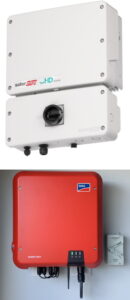Solar Inverter
Beginners Guide to Solar Inverters
In this blog we look at the different types of solar inverters available: string…
SolarBright partner with the leading inverter manufacturers supply and install high quality solar power inverters across Sydney and NSW. We partner with the leading brands including:
The inverter is the “brain” of your solar system. They convert Direct Current (DC) electricity produced by your solar panels into 240 volt Alternating Current (AC) electricity used in your home.
Most inverters for residential solar systems are string inverters, and support 2 strings of solar panels. Inverters are weather proof to IP65 rating or higher and are typically mounted an external wall near your meter box.
Solar Power Inverter Warranty
Most inverters came with a standard 5 year warranty for parts and labour. Often they come with an extra 5 years, normally shown as a 5+5 years warranty. Furthermore this extra warranty just covers parts or inverter replacement and customer then has to cover the labour costs.
Standard Residential Solar Power Inverter
For our standard residential solar system packages we offer the compact and smart looking Max Power Solar MPS 5000 5kW inverter. Firstly we offer this inverter as it is from Australian solar brand Max Power solar. Secondly it comes with an Australian backed 12-year parts and labour warranty. Thirdly, due to it’s dark colour it looks great.
When designing a commercial solar system we choose an inverter that best suits your needs. For commercial solar systems we recommend selected inverters and will design the system with several inverters in the system. This design means that if there is an issue with an inverter it will only affect the panels attached to that inverter.

Here are some of the frequently asked questions about Solar Inverters. If you still have any questions, please free to get in touch with us and one of our friendly team members will be happy to help.
A solar inverter takes the direct current (DC) from your solar panels and converts it to alternating current (AC) that your home can use. It’s like the brain of your system making sure there is energy ready to power your appliances.
The four main types of solar inverters are string inverters, hybrid inverters, power optimisers and microinverters. Each has its own benefits depending on your needs.
String inverters are the go-to choice for most homes. They’re affordable, reliable and great for rooftops with plenty of sun. Hybrid inverters are starting to become more popular as more people want battery storage to save extra energy.
Warranties vary and it’s important to check with each brand. Most of the well-known brands such as Sungrow and Solax Inverters come with 10 years warranty.
Choosing the best inverter comes down to your solar system’s size, your budget and needs. String inverters are ideal for most homes but if your roof has shade, power optimisers or microinverters might be better. Give our team a call, and we’ll help you find the perfect fit.